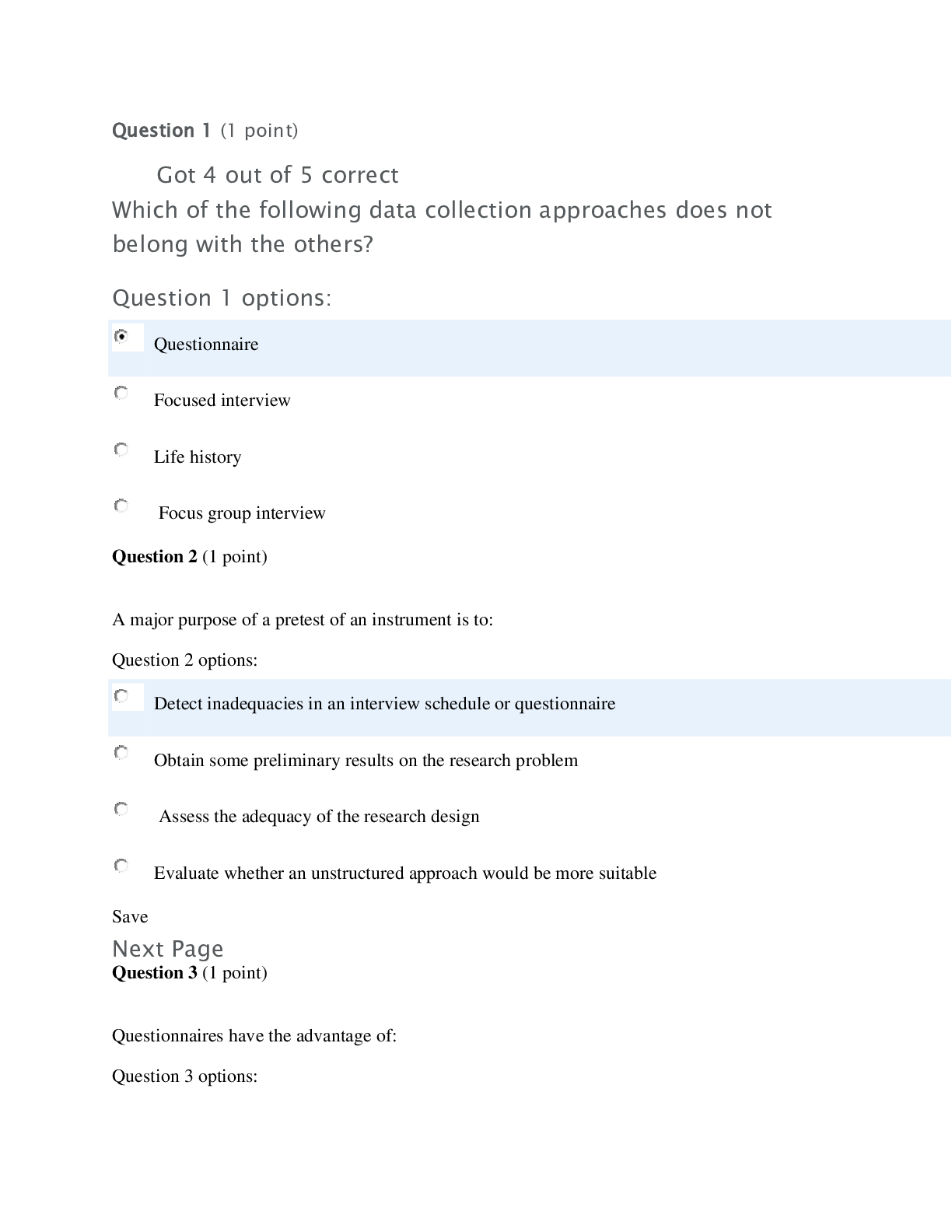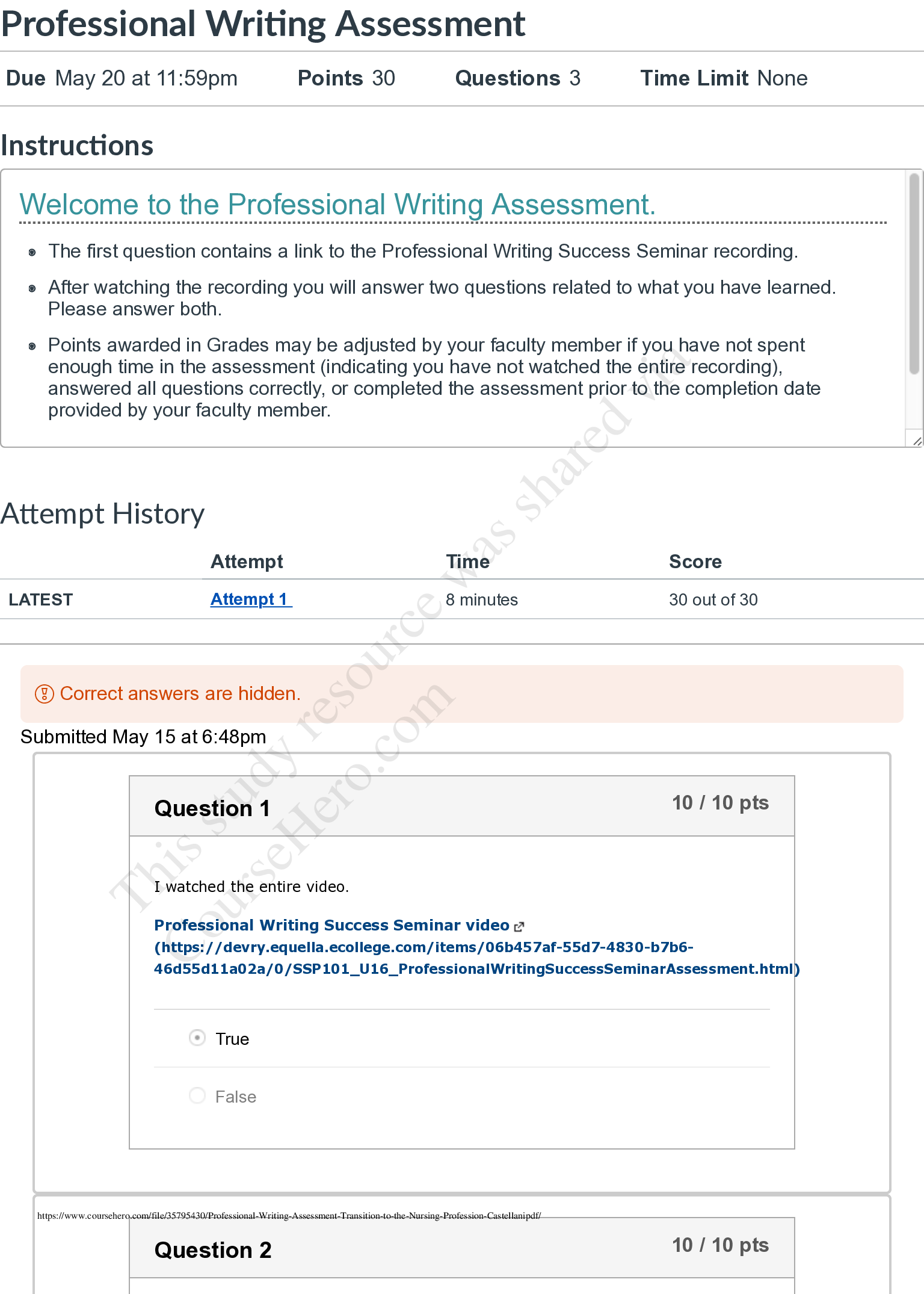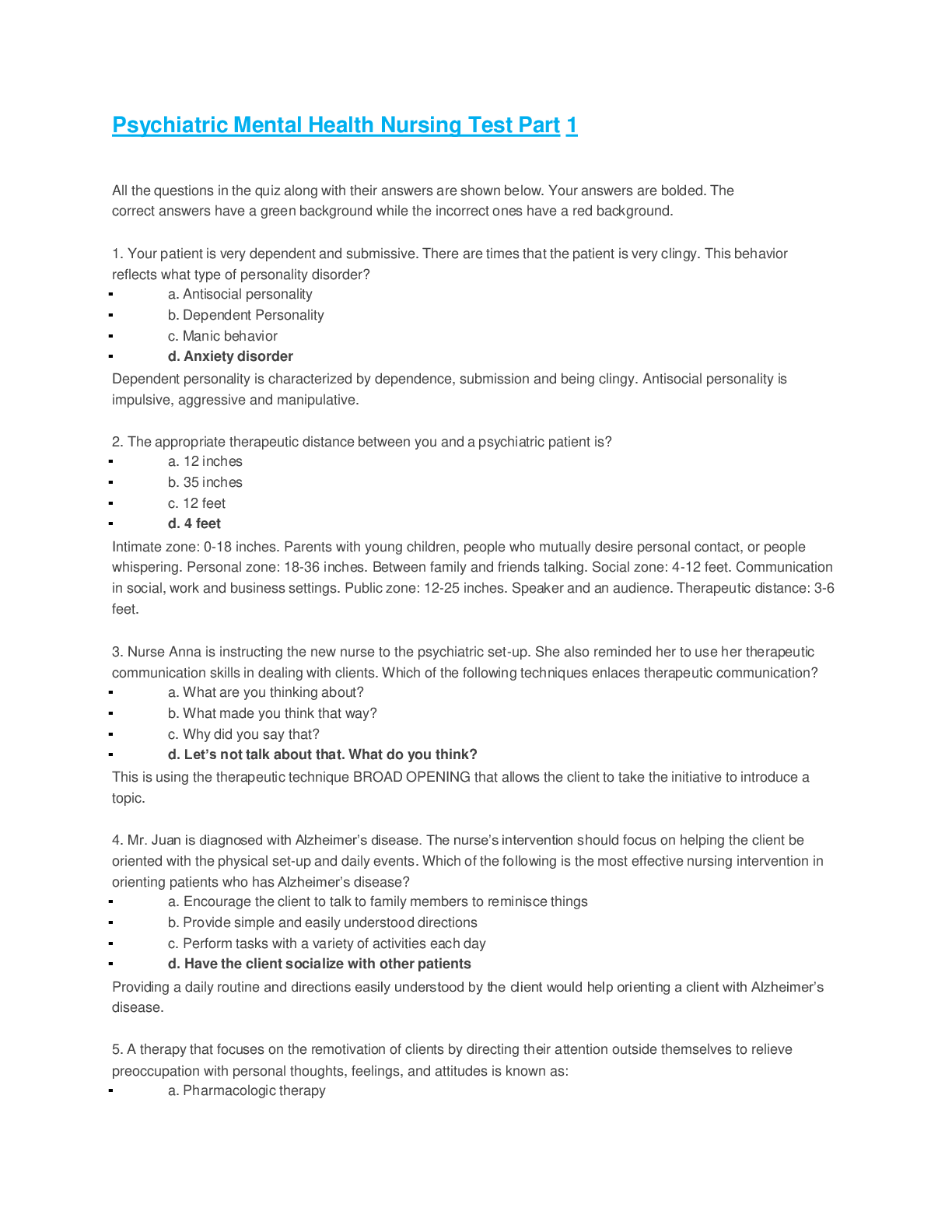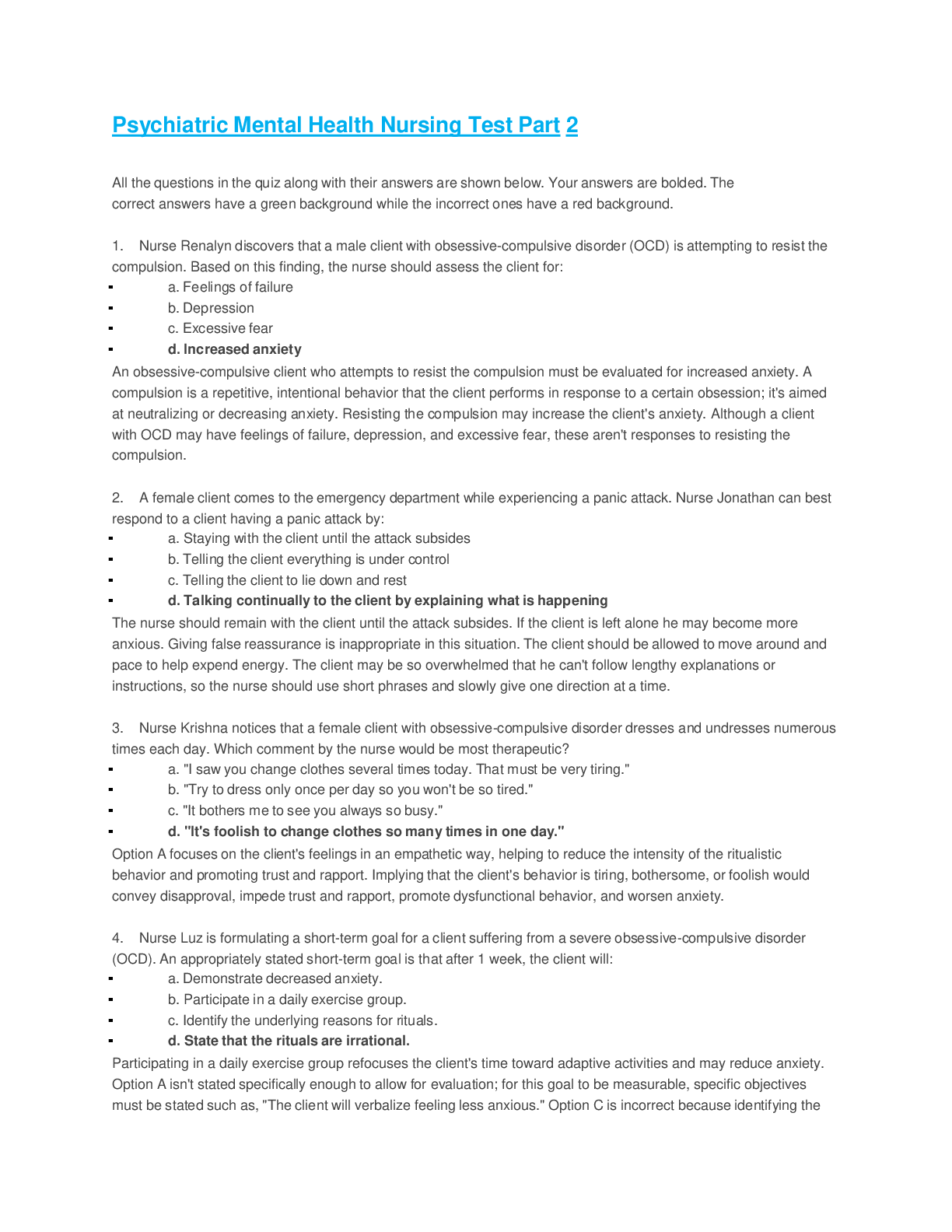Psychiatric Mental Health Nursing Test Part 1 ,2 and 3 (Latest Update)
Document Content and Description Below
Question: Your patient is very dependent and submissive. There are times that the patient is very clingy. This behavior reflects what type of personality disorder? Question: The appropriate therapeut... ic distance between you and a psychiatric patient is? Question: Nurse Anna is instructing the new nurse to the psychiatric set-up. She also reminded her to use her therapeutic communication skills in dealing with clients. Which of the following techniques enlaces therapeutic communication? Question: Juan is … with Alzheimer’s disease. The nurse’s intervention should focus on helping the client … oriented with the physical set-up and daily events. Which of the following is the most effective nursing intervention in orienting patients who has Alzheimer’s disease? Question: A therapy that focuses on the remotivation of clients by directing their attention outside themselves to relieve preoccupation with personal thoughts, feelings, and attitudes is known as: Question: The 12-year old male patient looks like the nurse’s younger brother who is missing for years. During assessment and in the implementation of nursing care the nurse prioritizes this client. One day, when she found the boy crying in his room she hugged him and cried with him. This is an example of: Question: A schizophrenic client is under your care. In reinforcing the functional behavior of this client what will the nurse do? Question: A client was … to the ER. Based on the significant others, the client had a history of shop stealing. However, no self-mutilating activities are … by the client. During the interview, the client is very manipulative and aggressive and impulsive. What personality disorder most likely the client has? Question: When the client told the nurse that he feels good when he mutilates or cuts himself the novice psychiatric nurse answered, “Do you know the risks involved when you cut yourself?” what type of nontherapeutic communication is the nurse using? Question: A therapy that assists with discharge planning and rehabilitation, focusing on vocational skills and activities of daily living (ADL) to raise self-esteem and promote independence is called: Question: Nurse Marie is caring for a patient that underwent alcohol detoxification. Which of the following symptoms would Nurse Marie … most concern? Question: The Distance that is observed when family members or friends are talking is under what zone: Question: The client is sharing Nurse Marie about his experiences. Suddenly, he paused, looked to the nurse and is hesitant to continue. The nurse responded, “Go on, and tell me about it.” What therapeutic communication technique is the nurse using? Question: In a therapeutic communication, “why questions” are … For what reason is this question not useful? Question: An 18 year old client is … Her mother told the nurse that she … drinking alcohol for the last 3 weeks and is … In caring for this patient what is the most important consideration? Question: In using a therapeutic communication technique interpreting client cues and signals is very important. Clear statements of intent such as the client saying that he wants to kill himself is a/an: Question: A client was … due to self-mutilation. One day during one of the sessions, the client told the nurse that cutting himself feels great. What would … the nurse’s best response? Question: A behavior that can indicate the speaker’s thoughts, feelings, needs and values that he or she acts out … : Question: Restraints are … reason. Which of the following is an appropriate reason for placing a client in restraints? Question: If a client is on restraints which of the following would the nurse do? Question: A client is … for an electroconvulsive therapy (ECT). Which of the following medications can … given to the client before the procedure? Question: To ensure that your client knows about the procedure, risks and outcome and … informed of the other alternative therapy. Which of the following must … accomplished? Question: The client says that he is hearing voices. What is nurse’s initial response? Question: What is the most important criteria that must … by the nurse before dealing with psychiatric patients? Question: If a client is a chain smoker, how should his medication dosage … adjusted? Question: Nurse Renalyn discovers that a male client with obsessive-compulsive disorder (OCD) is attempting to resist the compulsion. Based on this finding, the nurse should assess the client for: Question: A female client comes to the emergency department while experiencing a panic attack. Nurse Jonathan can best respond to a client having a panic attack by: Question: Nurse Krishna notices that a female client with obsessive-compulsive disorder dresses and undresses numerous times each day. Which comment by the nurse would be most therapeutic? Question: Nurse Luz is formulating a short-term goal for a client suffering from a severe obsessive-compulsive disorder (OCD). An appropriately stated short-term goal is that after 1 week, the client will: Question: Because antianxiety agents such as chlordiazepoxide (Librium) can potentiate the effects of other drugs, nurse Raquel should incorporate which of the following instructions in her teaching plan? Question: Danilo, arrives on the psychiatric unit exhibiting extreme excitement, disorientation, incoherent speech, agitation, frantic and aimless physical activity, and grandiose delusion. Which nursing diagnosis takes highest priority for the client at this time? Question: Gina, age 18, is highly dependent on her parents and fears leaving home to go away to college. Shortly before the fall semester starts, she complains that her legs are paralyzed and is rushed to the emergency department. When physical examination rules out a physical cause for her paralysis, the physician admits her to the psychiatric unit where she is diagnosed with conversion disorder. The client asks nurse Rose, “Why has this happened to me?” What is the nurse’s best response? Question: Dr. Luistro orders a new medication for a client with generalized anxiety disorder. During medication teaching, which statement or question by the nurse Kesselyn would be most appropriate? Question: After seeking help at an outpatient mental health clinic, a client … raped while walking her dog is … with posttraumatic stress disorder (PTSD). Three months later, the client returns to the clinic, complaining of fear, loss of control, and helpless feelings. Which nursing intervention is most appropriate for this client? Question: Jane is … to an inpatient psychiatric unit for treatment of obsessive-compulsive symptoms. Obsessive-compulsive disorder (OCD) is associated with: Question: A client with obsessive-compulsive disorder and ritualistic behavior must brush the hair back from his forehead 15 times before carrying out any activity. Nurse Leo notices that the client’s hair is thinning and the skin on the forehead is irritated — possible effects of this ritual. When planning the client’s care, the nurse should assign highest priority to: Question: During alprazolam (Xanax) therapy, nurse Rachel should … alert for which dose-related adverse reaction? Question: A client is … to the psychiatric unit with a diagnosis of conversion disorder. Since witnessing the beating of his wife at gunpoint, he … unable to move his arms, complaining that they are paralyzed. When planning the client’s care, nurse Jay should focus on: Question: A male client with borderline personality disorder tells nurse Valerie, “You’re the only nurse who really understands me. The others are mean.” The client then asks the nurse for an extra dose of antianxiety medication because of increased anxiety. How should the nurse respond? Question: Angel, is … to the unit visibly anxious. When assessing her, the nurse would expect to see which of the following cardiovascular effects produced by the sympathetic nervous system? Question: A male client with Alzheimer’s disease has a nursing diagnosis of Risk for injury related to memory loss, wandering, and disorientation. Which nursing intervention should appear in this client’s plan of care to prevent injury? Question: Rudy … in a local park is unable to state who or where he is or where he lives. He is … to the emergency department, where his … The client’s wife states that he was … with Alzheimer’s disease 3 years ago and … increasing memory loss. She tells nurseAngelie she is … about how she’ll continue to care for him. Which response by the nurse would be most helpful? Question: Nurse Agnes is aware that nursing action most appropriate when trying to diffuse a male client’s impending violent behavior? Question: A male client has been taking imipramine (Tofranil), 125 mg by mouth daily, for 1 week. Now the client reports wanting to stop taking the medication because he still feels depressed. At this time, what is the best response of nurse Charlyn? Question: A male client with Alzheimer’s disease mumbles incoherently and rambles in a confused manner. To help redirect the client’s attention, nurse Mark should encourage the client to: Question: Nurse Francis is aware that the nursing preparations for a client undergoing electroconvulsive therapy (ECT) resemble those used for: Question: Nurse Hershey must administer activated charcoal before administering certain other drugs to a client who’s taken an overdose. Which drug is … inactive when administered concomitantly with activated charcoal? Question: Dr. Tan orders electroconvulsive therapy (ECT) for a severely depressed client who fails to respond to drug therapy. When teaching the client and family about this treatment, nurse Bernadeth should include which most important point about ECT? Question: Julius, an adolescent becomes increasingly withdrawn, is irritable with family members, and has been getting lower grades in school. After giving away a stereo and some favorite clothes, the adolescent is … to the community mental health agency for evaluation. This adolescent is at risk for: Question: Nurse Bea is aware the when preparing a client for electroconvulsive therapy (ECT), she should make sure that: [Show More]
Last updated: 1 year ago
Preview 1 out of 64 pages
Instant download

Buy this document to get the full access instantly
Instant Download Access after purchase
Add to cartInstant download
Reviews( 0 )
Document information
Connected school, study & course
About the document
Uploaded On
Dec 05, 2020
Number of pages
64
Written in
Additional information
This document has been written for:
Uploaded
Dec 05, 2020
Downloads
0
Views
36





.png)













